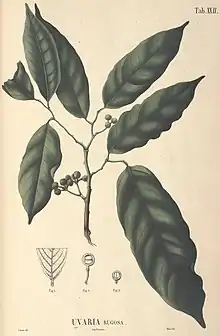| Pseuduvaria rugosa | |
|---|---|
 | |
| Botanical illustration of Pseuduvaria rugosa using the synonym Uvaria rugosa | |
| Scientific classification | |
| Kingdom: | Plantae |
| Clade: | Tracheophytes |
| Clade: | Angiosperms |
| Clade: | Magnoliids |
| Order: | Magnoliales |
| Family: | Annonaceae |
| Genus: | Pseuduvaria |
| Species: | P. rugosa |
| Binomial name | |
| Pseuduvaria rugosa | |
| Synonyms | |
|
Mitrephora micrantha Teijsm. & Binn. | |
Pseuduvaria rugosa is a species of plant in the family Annonaceae.[2] It is native to Java, Laos, the Lesser Sunda Islands, Peninsular Malaysia, Myanmar, the Nicobar Islands, Sumatra and Thailand.[3] Carl Ludwig Blume, the botanist who first formally described the species under the basionym Uvaria rugosa, named it after its wrinkled (rugosus in Latin) fruit.[4][5]
Description
It is a tree reaching 40 meters in height. The young, dark brown to black branches are densely hairy but become hairless as they mature. Its elliptical to egg-shaped, papery to slightly leathery leaves are 10-23 by 3–8.5 centimeters. The leaves have pointed, wedge-shaped or blunt bases and tapering tips, with the tapering portion 6-15 millimeters long. The leaves are hairless on their upper and lower surfaces. The leaves have 10-18 pairs of secondary veins emanating from their midribs. Its sparsely to densely hairy petioles are 4-12 by 0.8-3 millimeters with a narrow groove on their upper side. Its Inflorescences occur in groups of 3–6 on branches, and are organized on very densely hairy peduncles that are 1.5-4 by 0.5-0.7 millimeters. Each inflorescence has 1-2 flowers. Each flower is on a very densely hairy pedicel that is 7-24 by 0.3-0.8 millimeters. The pedicels are organized on a rachis up to 5 millimeters long that have 3 bracts. The pedicels have a medial, very densely hairy bract that is 0.5-1.5 millimeters long. Its flowers are unisexual. Its flowers have 3 free, triangular sepals that are 0.9-1.5 by 0.8-1.5 millimeters. The sepals are hairless on their upper surface, very densely hairy on their lower surface, and hairy at their margins. Its 6 petals are arranged in two rows of 3. The light yellow-green, oval to elliptical, outer petals are 1–2.5 by 1–2.5 millimeters with hairless upper and very densely hairy lower surfaces. The inner petals are red-purple to red-brown on their upper surfaces and light-yellow-green on their lower surfaces. The diamond-shaped inner petals have a 3–7.5 millimeter long claw at their base and a 4-10 by 2-4 millimeter blade. The inner petals have pointed bases and tips. The inner petals are very densely hairy on their upper and lower surfaces. Male flowers have 30-58 stamens that are 0.5-0.8 by 0.4-0.7 millimeters. Female flowers have 5-13 carpels that are 1-1.5 by 0.5-0.8 millimeters. Each carpel has 2-6 ovules arranged in two rows. Female flowers can have 4-6 sterile stamens. The fruit occur in clusters of 1-9 and are organized on densely hairy peduncles that are 3-5 by 1-2 millimeters. The fruit are attached by sparsely hairy pedicles that are 12-27 by 0.8-3 millimeters. The yellow-green to brown, globe-shaped fruit are 10-20 by 10-20 millimeters. The fruit are winkled, and very densely hairy. Each fruit has 2-6 hemispherical to lens-shaped seeds that are 10-14 by 5–7.5 by 3.5-5 millimeters. The seeds are wrinkled.[6]
Reproductive biology
Habitat and distribution
It has been observed growing on granite and limestone substrates in evergreen forests, dry ridge forests, or freshwater swamp forests, at elevations of 100–450 meters.[6]
Uses
Bioactive molecules extracted from its leaves and twigs have been reported to have cytostatic activity in tests with cultured human cancer cell lines.[9]
References
- ↑ Verspagen, N.; Erkens, R.H.J.; Daniels, A. (2021). "Pseuduvaria rugosa". IUCN Red List of Threatened Species. 2021: e.T179885937A179885943. doi:10.2305/IUCN.UK.2021-2.RLTS.T179885937A179885943.en. Retrieved 20 June 2022.
- ↑ "Pseuduvaria rugosa (Blume) Merr". Catalogue of Life. Species 2000. n.d. Retrieved August 9, 2021.
- ↑ "Pseuduvaria rugosa (Blume) Merr". Plants of the World Online. The Trustees of the Royal Botanic Gardens, Kew. n.d. Retrieved August 9, 2021.
- ↑ Stearn, William (2004). Botanical Latin. Portland, Ore. Newton Abbot: Timber Press David & Charles. ISBN 9780881926279.
- ↑ Blume, Carl Ludwig (1830). Flora Javae nec non Insularum Adjacentium [Flora of Java as well as of the Adjacent Islands] (in Latin). Vol. 2. Brussels: J. Frank. p. 47.
- 1 2 Su, Yvonne C.F.; Saunders, Richard M.K. (2006). Monograph of Pseuduvaria (Annonaceae). Systematic Botany Monographs. Vol. 79. American Society of Plant Taxonomists. pp. 1–204. JSTOR 25027955.
- ↑ Su, Yvonne C. F.; Saunders, Richard M. K. (2003). "Pollen structure, tetrad cohesion and pollen-connecting threads in Pseuduvaria (Annonaceae)". Botanical Journal of the Linnean Society. 143 (1): 69–78. doi:10.1046/j.1095-8339.2003.00204.x. ISSN 1095-8339.
- ↑ Walker, James W. (1971). "Pollen Morphology, Phytogeography, and Phylogeny of the Annonaceae". Contributions from the Gray Herbarium of Harvard University. 202 (202): 1–130. JSTOR 41764703.
- ↑ Uadkla, Orathai; Yodkeeree, Supachai; Buayairaksa, Mongkol; Meepowpan, Puttinan; Nuntasaen, Narong; Limtrakul, Pornngarm; Pompimon, Wilart (2013). "Antiproliferative effect of alkaloids viac ell cycle arrest from Pseuduvaria rugosa". Pharmaceutical Biology. 51 (3): 400–404. doi:10.3109/13880209.2012.734314. ISSN 1388-0209.
